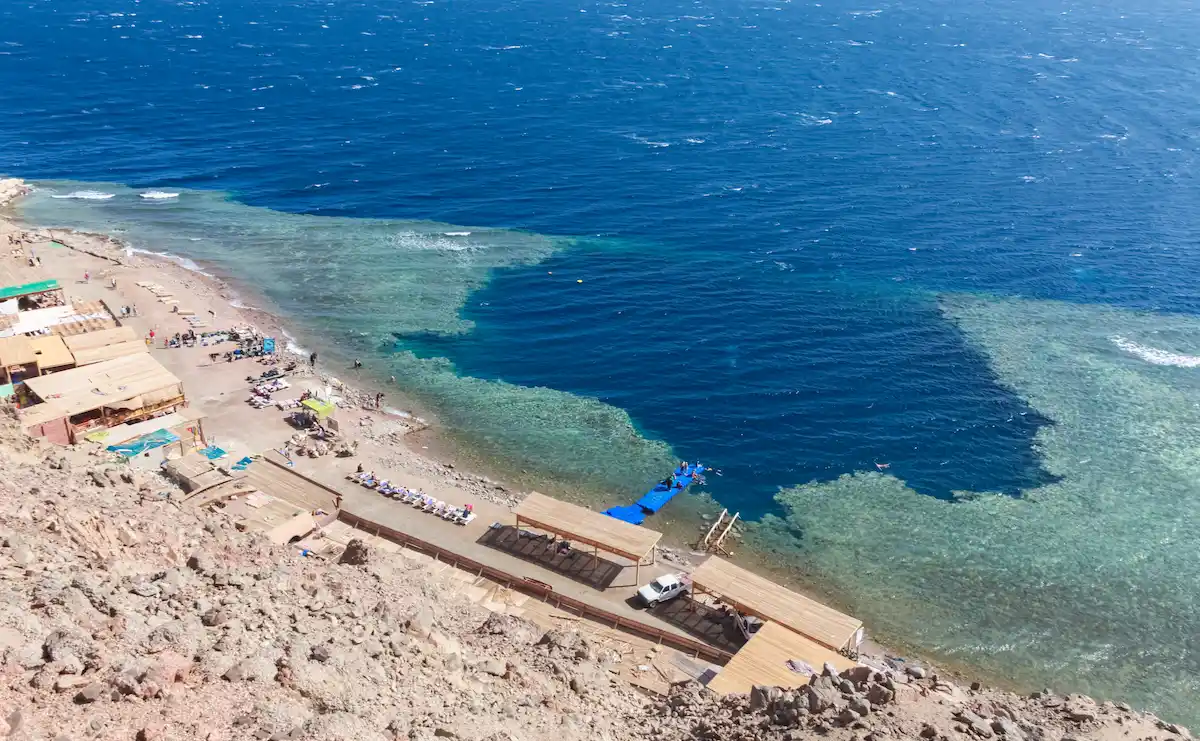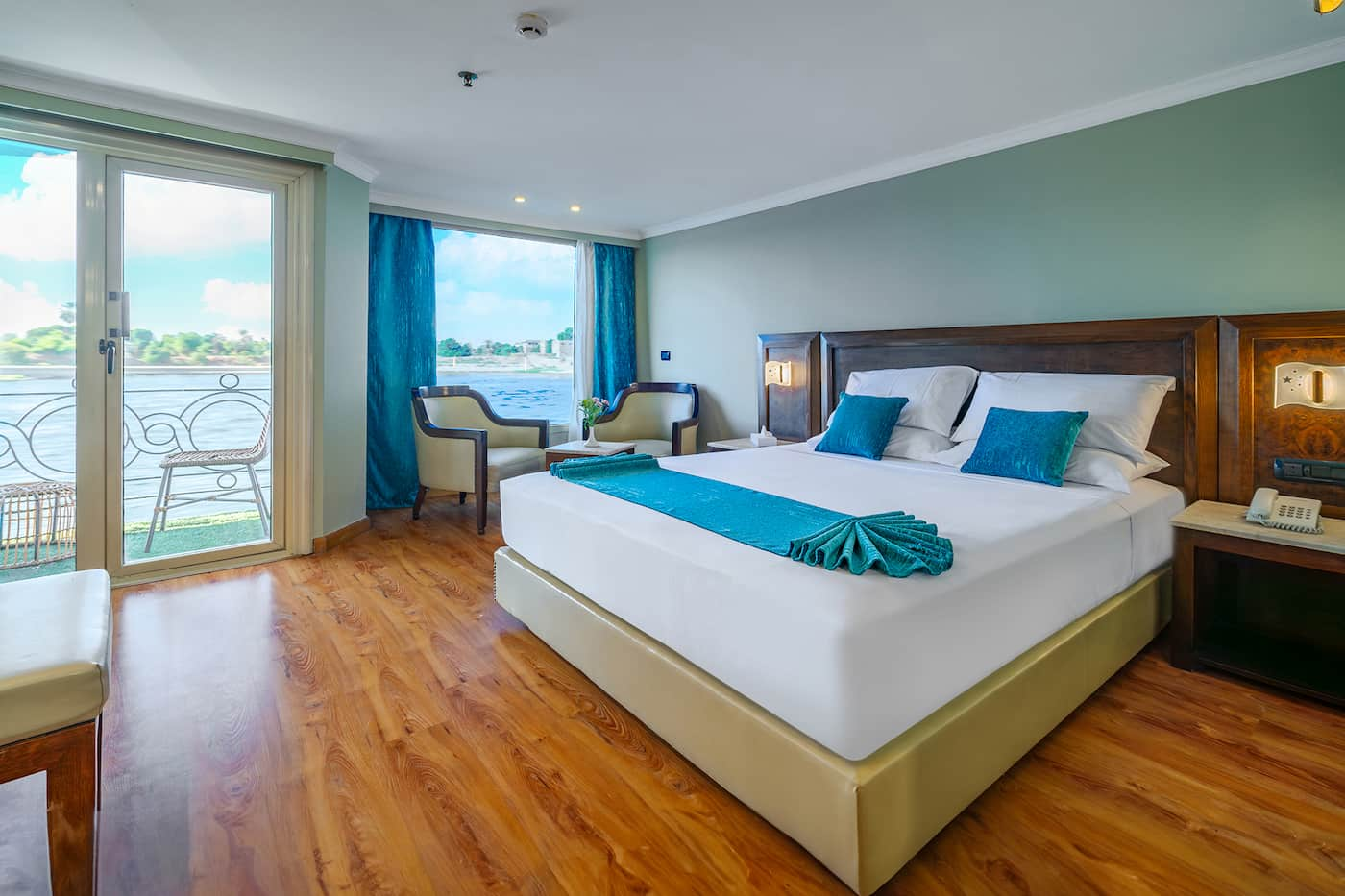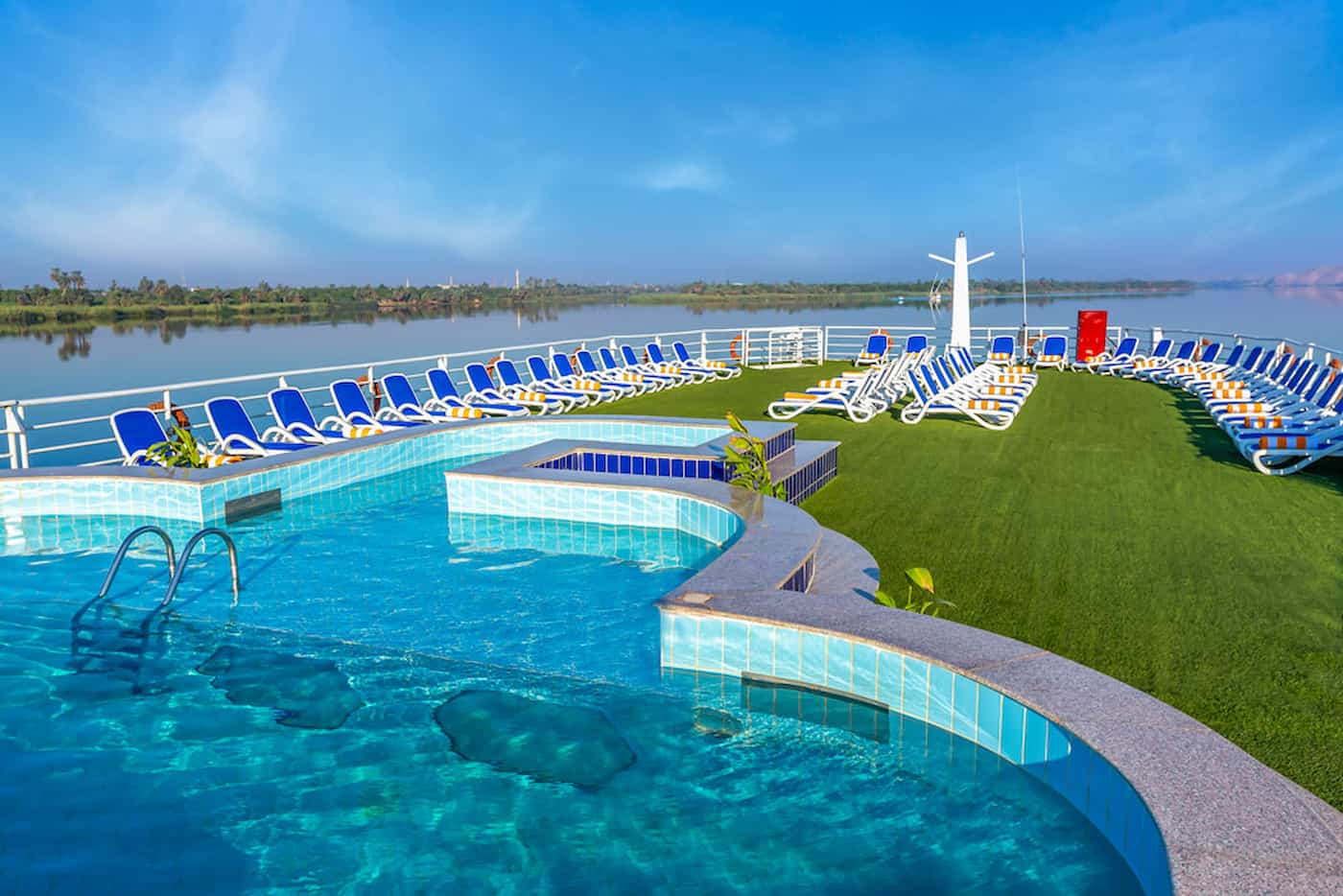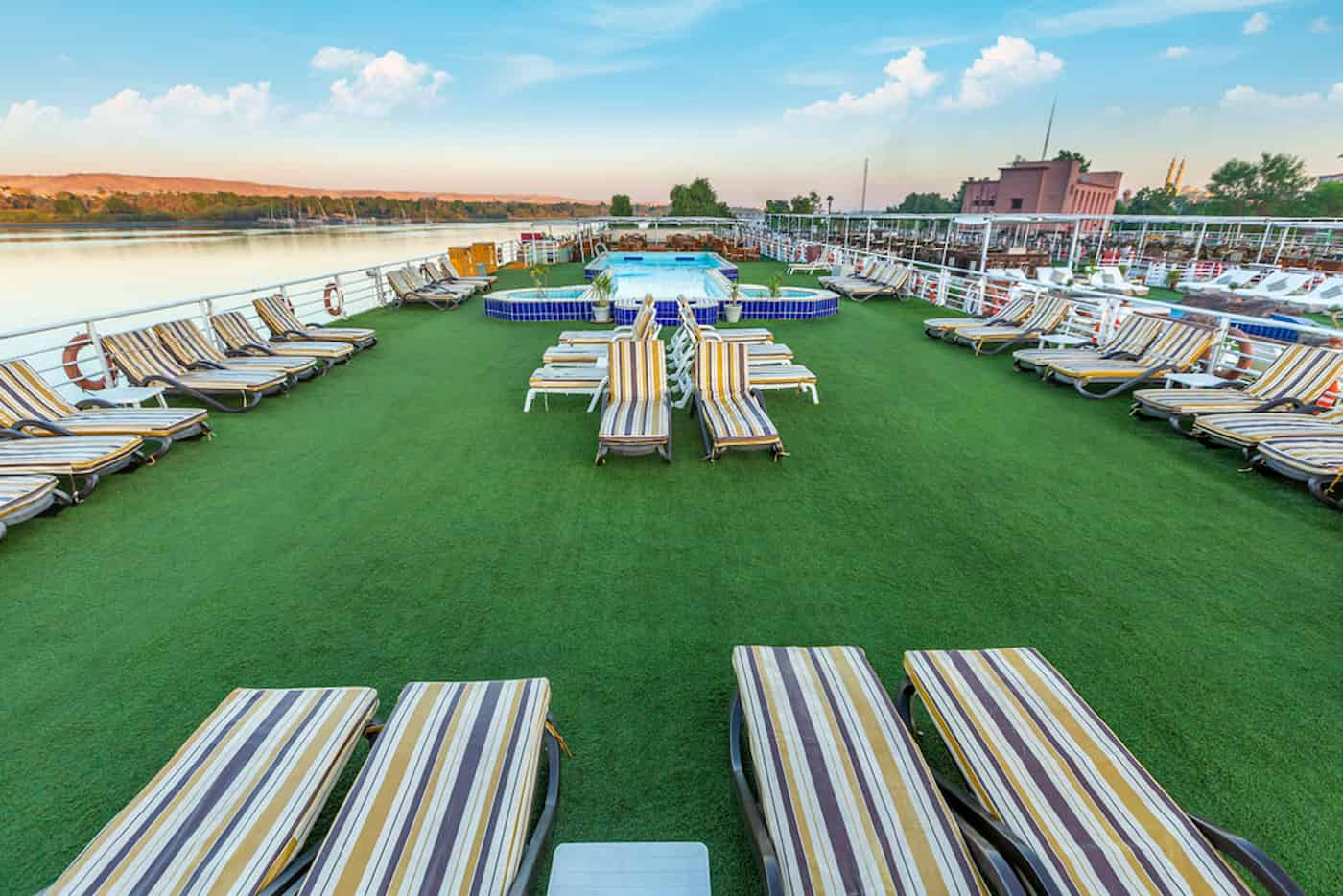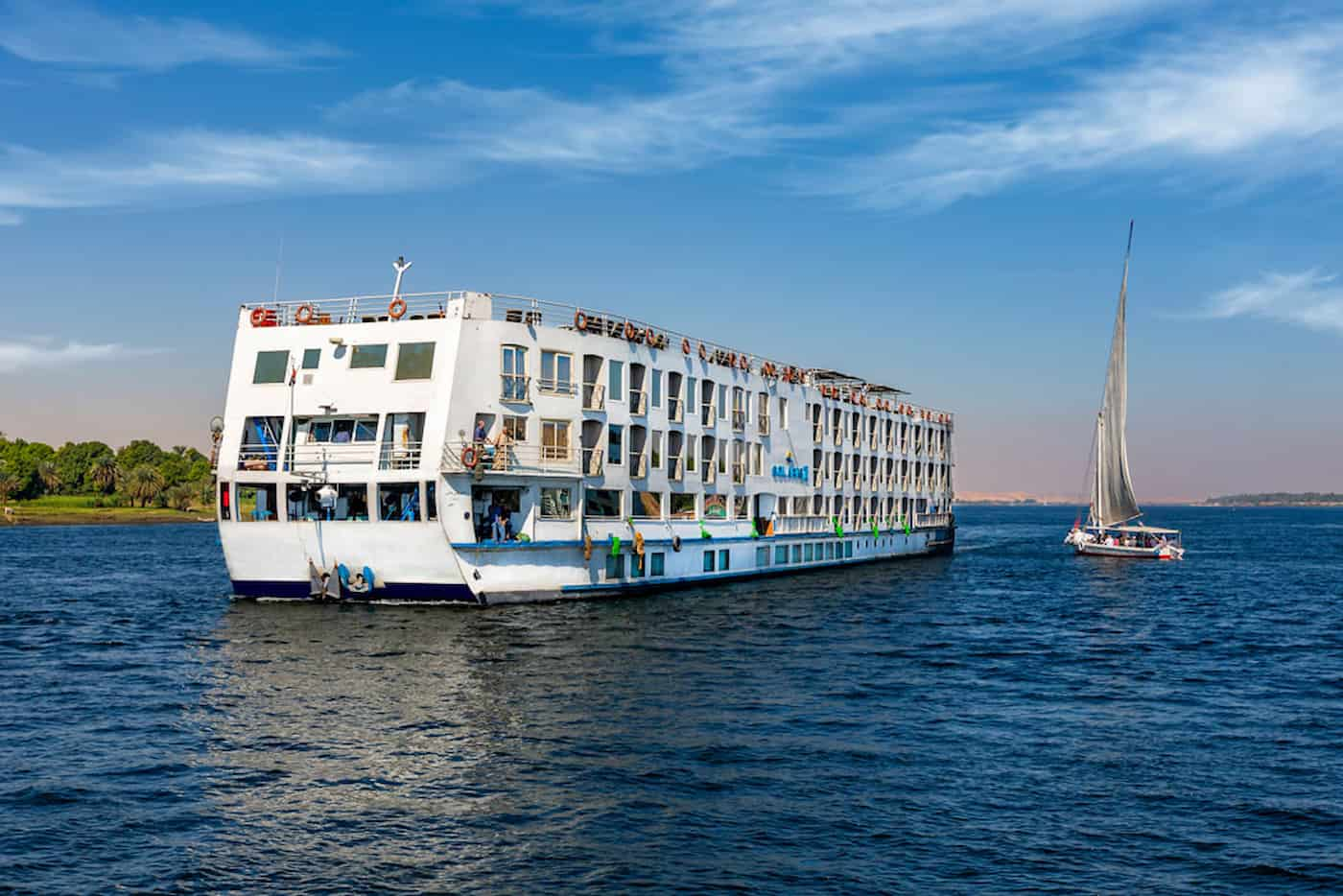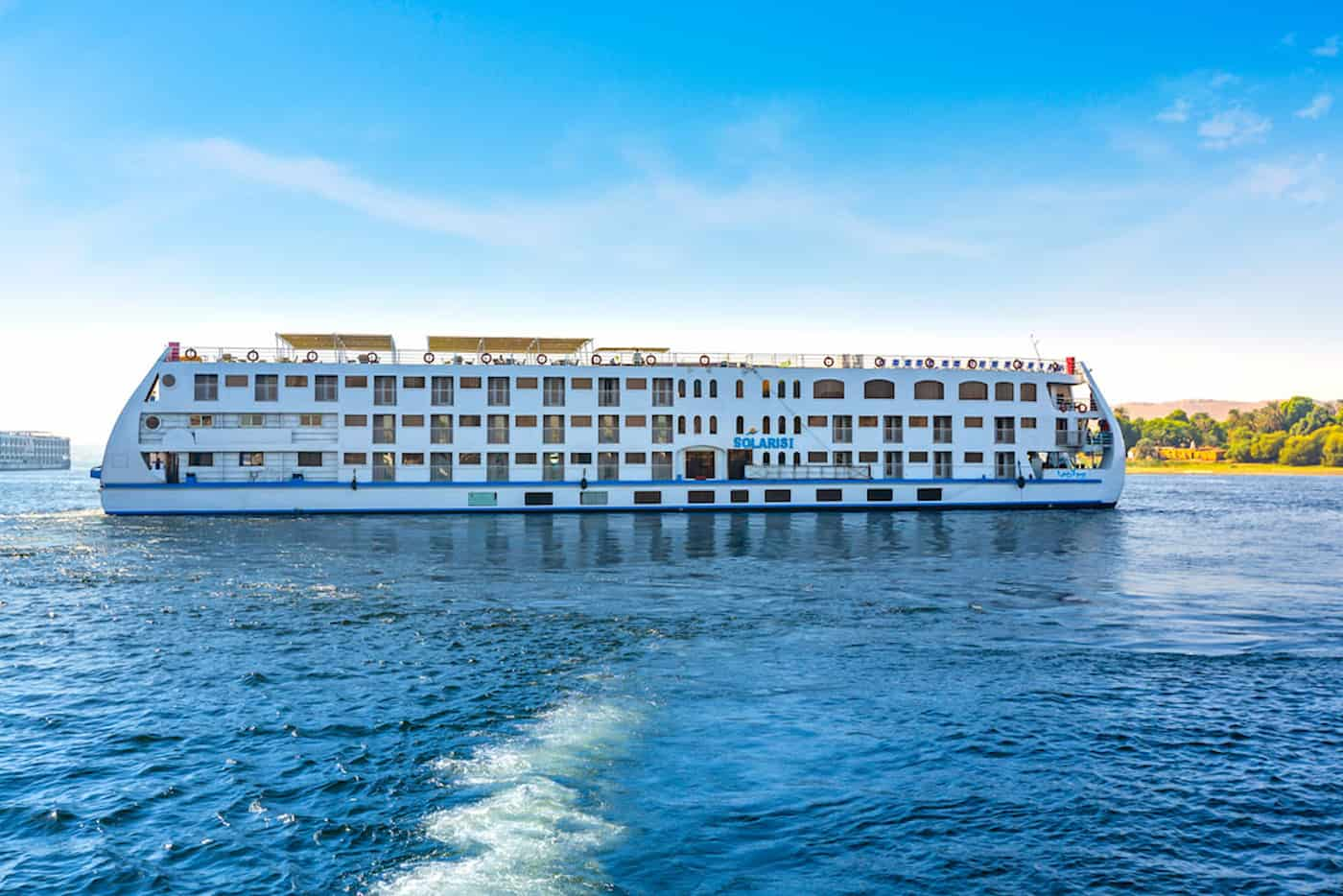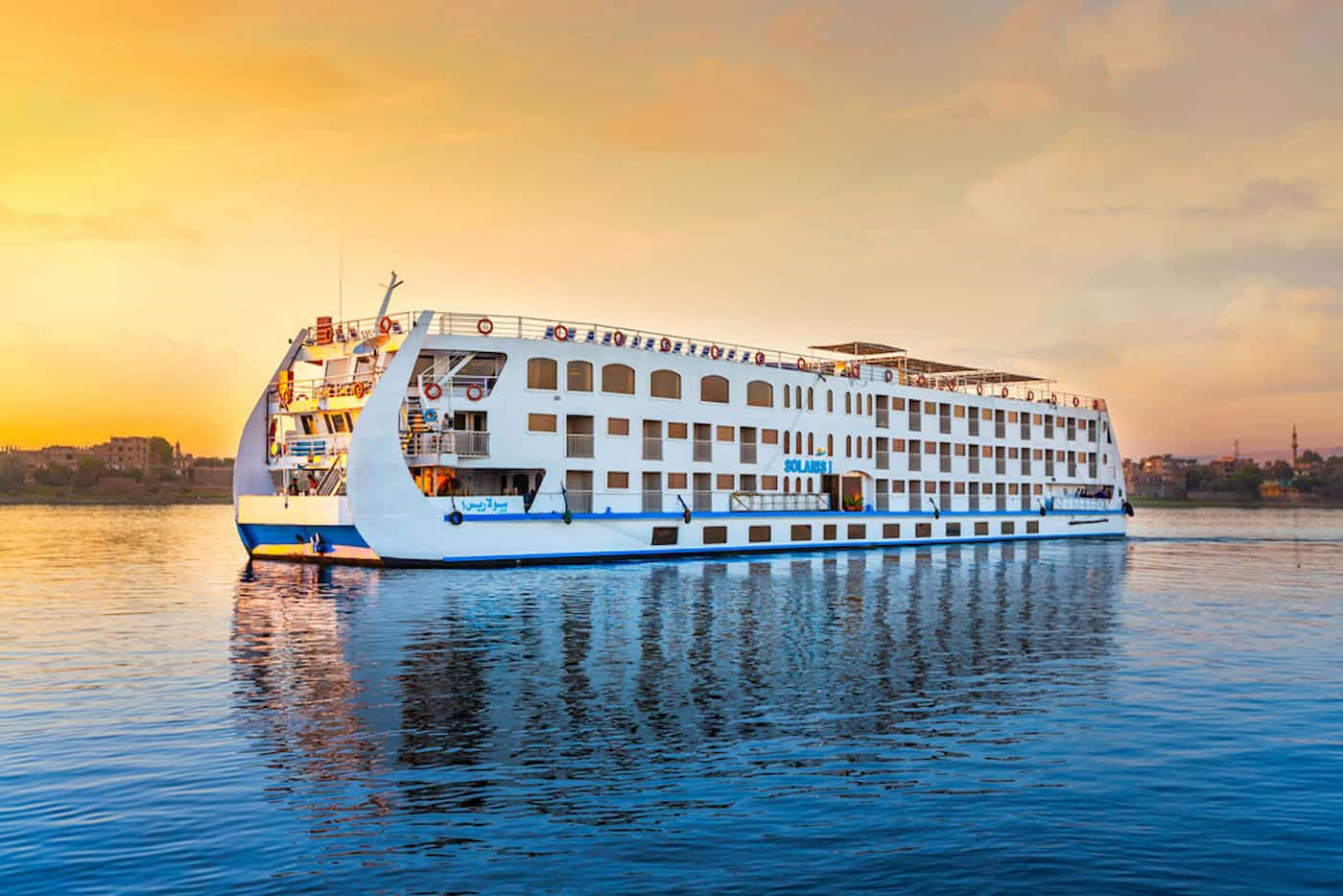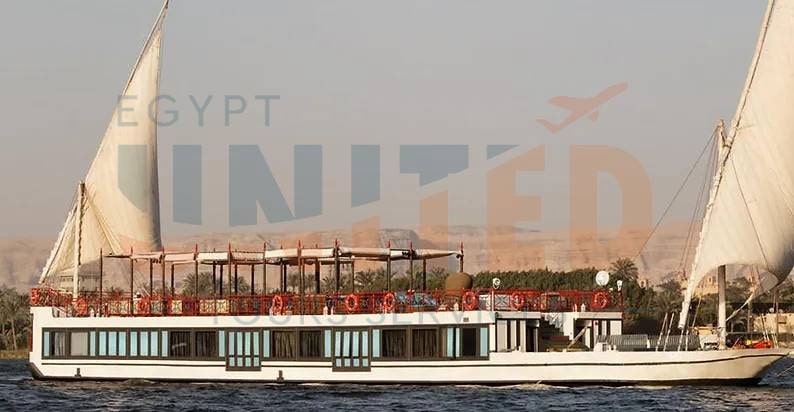Blue Hole Scuba Diving Egypt: The Ultimate Guide to Dahab’s Legendary Dive Site
Egypt is infamous for being the ocean diver’s ultimate getaway, featuring the Red Sea, which is clear and clogged with coral and strange fish. Although the country excels in many aspects, one particular location surpasses all others. This is the Blue Hole in Dahab. The natural hole is both fascinating and fearsome.
Often labeled as “pretty but deadly,” the Blue Hole is adored because of its striking length, beautiful coral landscape, and the range of its marine life. It also has a charm, as it happens to be one of the most dangerous diving spots in the world. An amalgamation of appeal and peril has elevated it to the status of a legend within the dive community.
It is a known fact that divers from far-reaching areas of the world undertake an annual trip to Dahab simply to dive in its crystal-clear waters, rich underwater landscapes, and explore the most challenging or complex dive sites referred to in the dive tables. Let’s discover the Blue Hole scuba diving in egypt
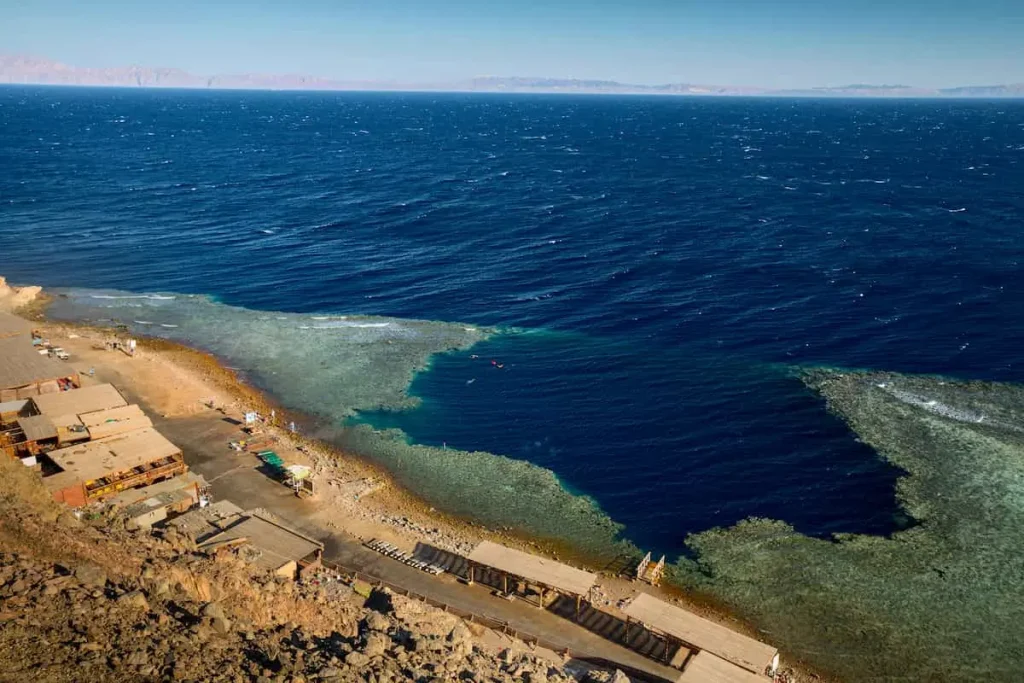
1. Where is the Blue Hole Located in Egypt?
When you visit Egypt for the great scuba diving, you cannot afford not to see the Blue Hole in Dahab. You only have to drive north of the laid-back town in the South Sinai Peninsula, Dahab. It is a coastal beauty, and it is at most an hour’s drive from Sharm El-Sheikh. Access is also available from Cairo through internal flights, and one then has to look for a means of transport.
Surrounded by jagged desert ranges and the blue waters of the Red Sea, the Blue Hole can be easily reached in a matter of fifteen minutes from the town of Dahab, with beautiful views on the way. The site itself juts out into the sea, and diving boats will not be necessary, hence the name shore dive. Nowhere else in the world does this happen. No boats are required for access to sites with dive centers; gear up on the beach and set off, ready for one of the best places to dive in history.
This capability, alongside the quiet charm of Dahab, which is known for its oceanic delights, inspires anyone who loves fun and beauty at the same time in the ocean to check the Blue Hole of Egypt in the Red Sea.
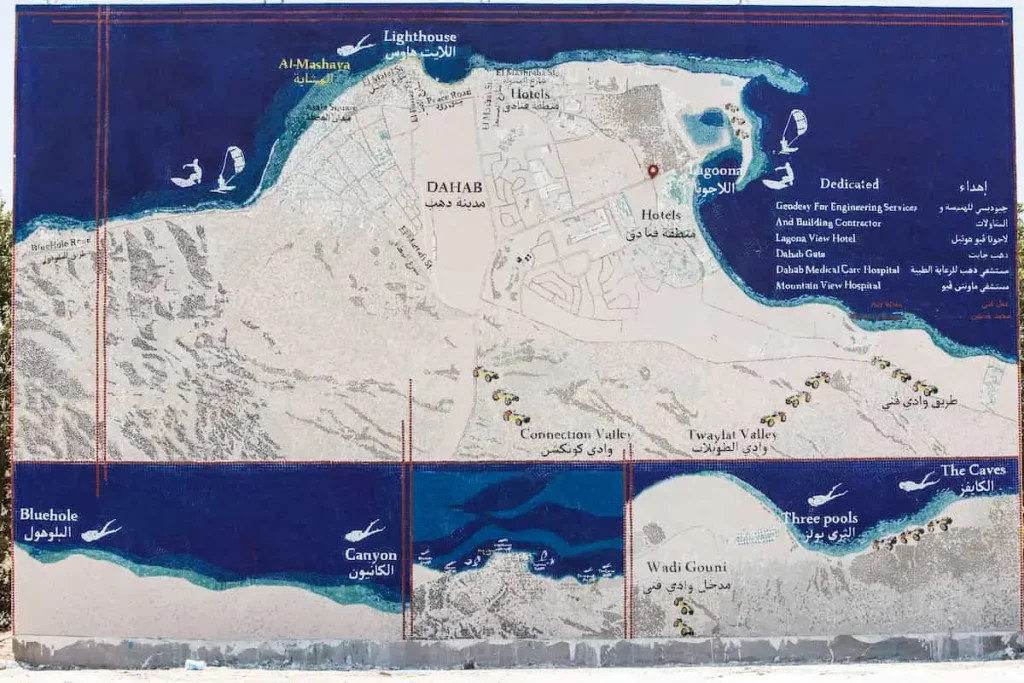
Tourist map of Dahab showing diving and kitesurfing spots including Blue Hole and Lagoon.
3. Geological & Natural Features of The Blue Hole
The dramatic and stunning natural formation of Blue Hole scuba diving in Egypt goes a long way in making it highly iconic. It is a vertical shaft of more than a hundred meters deep, the unique shade of sapphire blue of its water creates a nearly symmetrical circle, and this color does not match the lighter turquoise of the distant reef. According to some estimates, the deep width here reduces the principles of buoyancy, due to which the divers feel like they are floating over the boundless underwater air grave.
Another common attraction is the Arch. A submerged cavern through which a body of water passes can be about 26 meters long and connects the Blue Hole to the open Red Sea at a depth of around 56 meters. Visually appealing as the Arch is, it is also a landmark for dangerous diving that only a few specially trained, very technical divers can attempt.
Scenery of the Blue Hole in the backdrop, the descending cliff is surrounded by gentle and beautiful coral reefs with shallows surrounding the gorge. Almost always underwater, the place is as wonderful as it is frightening due to such a composition. This makes the destination one of the most unbeatable dive sites globally.
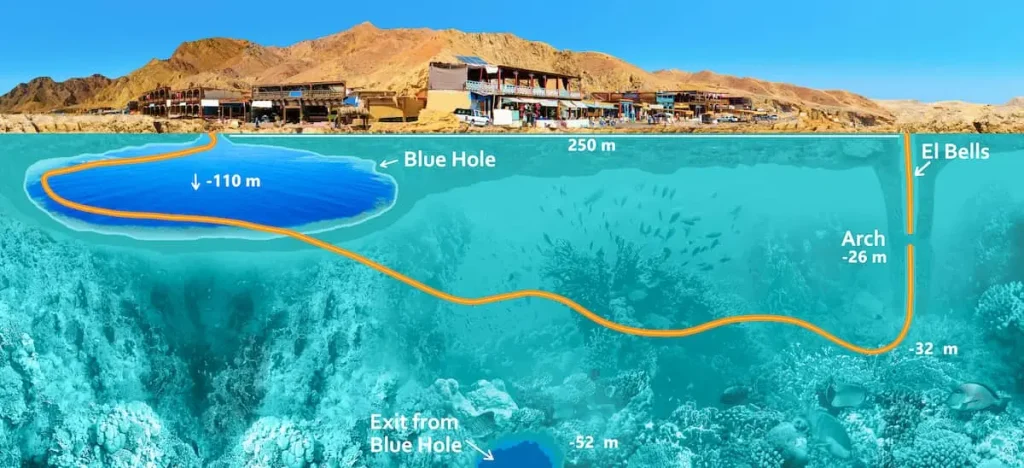
4. Diving Experience at the Blue Hole
To many travelers, Egypt is not complete without scuba diving in the Blue Hole. There are several diving routes to take at the site, with each target group. No wonder there are so many people who don’t feel like moving to another place.
The most famous complex has the Bells to Blue Hole dive. A narrow passage known as the Bells is descended by a scuba diver before cruising through superbly overgrown vertical walls with corals. Then go to the Blue Hole itself until it passes the surface of the open ocean into amazing sight: a desert of a blue hole.
For beginners, Blue Hole presents itself as an easy entry with a lead that has to stay near the shore only. There is not much of a distance to cover; after that, a myriad of sea life will welcome every. Such a visual factor helps mitigate the risks of the most favourable conditions.
One tends to overtake the other. Operational depths are also different and dependent on one’s skill and certificate. Recreational divers are usually catered for above 30m, while technical divers go beyond this depth, and some even explore the Arch. The Blue Hole captures the divers’ excitement because of its unusual visibility, cliffs, and the incredible feeling of being a speck in the big picture. No matter how experienced the diver is, none of the dives can be boring, ever.
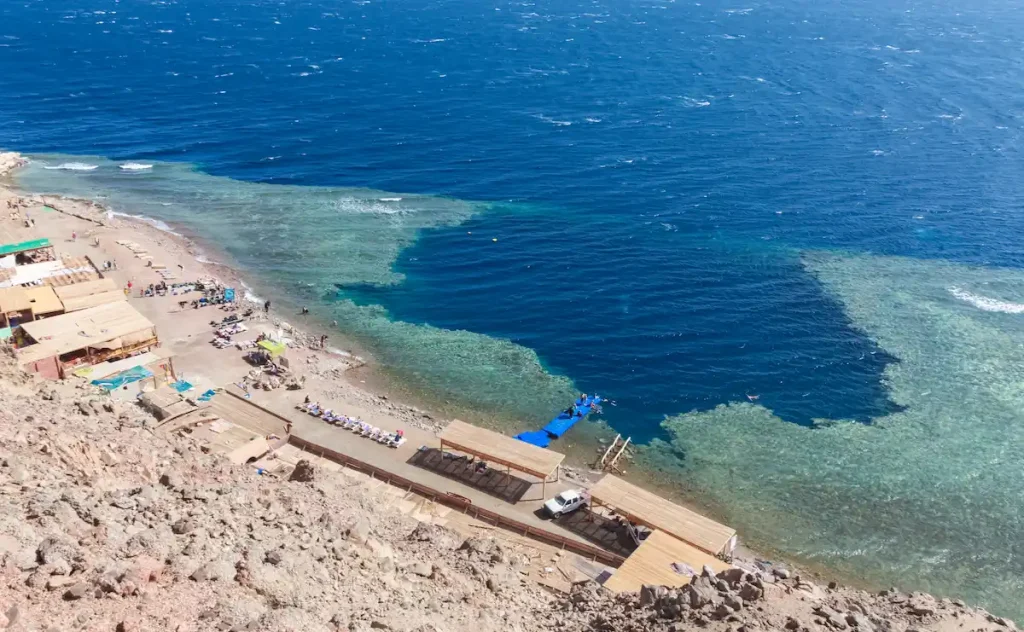
5. Marine Life & Biodiversity of The Blue Hole in Egypt
In addition to its mesmerizing ancient rocks, the Blue Hole scuba diving in Egypt is very famous for its dynamic underwater ecosystem. This location is characterized by an excellent population of tropical marine fish, as it boasts a vividly colored coral reef with hard and soft living corals decorated on the walls and in the shallow waters. There are plenty of so many types of fish because of the amazing corals.
Many times, divers see all the beautiful reef fish swimming amongst the corals, exceptionally large groupers in hideouts, and silver barracudas swimming from side to side in the middle of the blue sea. Smaller fish also swim in populations that dance in the sun, making them add movement and reality to the abyssal blue of the sea.
Then there are other times, in moments of particular significance, when divers can contribute themselves to be in the right place at the right time and meet sea turtles, reef sharks, and sometimes, albeit very rarely, Brenda the spotted unicorn fish. The vast and varied environment ensures that each dive location can offer quite different experiences with each dive.
With its incredibly beautiful formations of corals and sea animals, the Blue Hole is not just a thrilling dive site but a vibrant underwater habitat that presents the most appealing characteristics of the Red Sea.
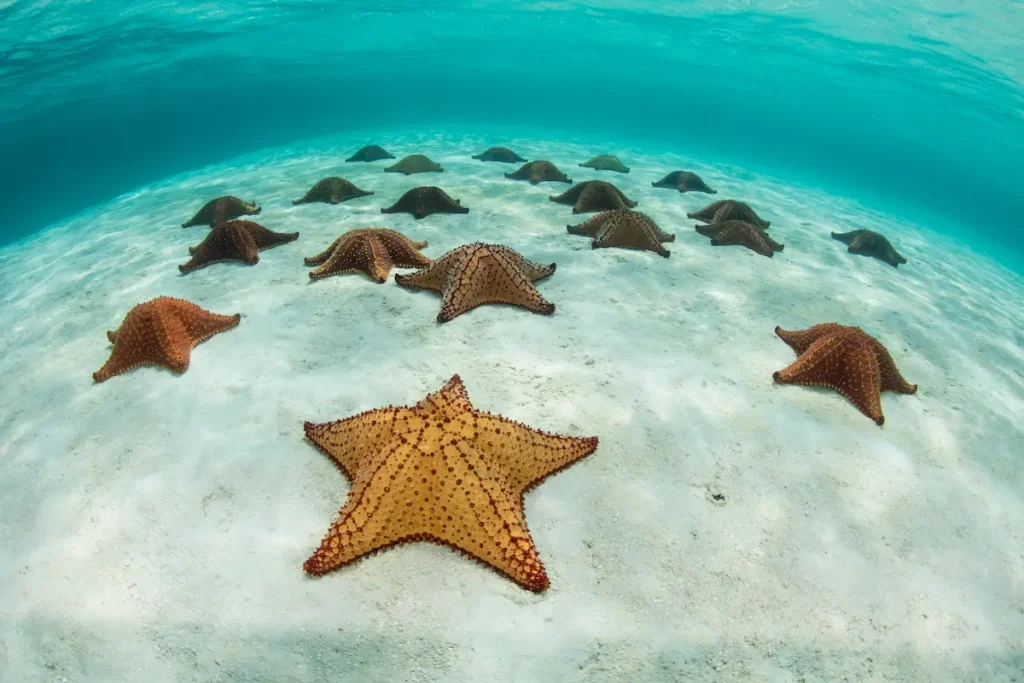
6. The Risks & Safety Concerns
While breathtakingly beautiful, Blue Hole scuba diving in Egypt is also surrounded by a reputation for danger. Often nicknamed the “World’s Most Dangerous Dive Site,” the Blue Hole has challenged even experienced divers due to its extreme depth and deceptive environment.
The main risks include nitrogen narcosis at deeper levels, which can impair judgment, and the overwhelming sense of vastness that can cause disorientation. The most infamous hazard is the Arch, a 26-meter-wide tunnel connecting the Blue Hole to the open sea at a depth of around 56 meters. Many divers underestimate the difficulty of reaching and exiting this passage, leading to accidents in the past.
That said, thousands of divers safely enjoy the Blue Hole every year by following simple safety rules:
-
✅ Only dive within your certification limits. Stay at recreational depths if you are not technically trained.
-
✅ Always dive with a certified local guide familiar with the site’s conditions.
-
✅ Avoid deep penetration into the Arch unless you hold proper technical diving qualifications.
Approached with respect and preparation, the Blue Hole can be both safe and unforgettable, offering divers a thrilling but responsible adventure. But it is always better to book your tour with a trusted tourism company like Egypt United Tours for the best services.
7. Who Can Dive In The Blue Hole in Egypt?
Regarding Blue Hole of Egypt scuba diving, not everyone is ready for the same level of diving adventure. The site’s depth and rough conditions make it a place for experienced divers only.
The shallow reef part of Blue Hole Omayed and Blue Hole is definitely something that Advanced Open Water Divers and divers who meet its performance requirements will enjoy. Snorkeling in these areas will be safe and exciting, with one getting to see a great deal of marine life and other things such as soft and hard corals. And all these are done within the breadth of the world’s most popular deep blue hole, as no decompression limits are exceeded.
And given the depth of the Arch and its associated descents, only some special Go Dive will be able to dive this. Such activities demand an added qualification; knowledge of the utilization of gas blends, other mixtures, and even overcasts is required. Such penetrations are very threatening if one is not correctly qualified.
Those who lack the training and qualification to scuba dive can still have a great time at the Bhero Blue Hole. Beginners and non-certified swimmers alike get to see the colorful coral in the area and the various schools of fish in the water by engaging in shallow diving on the far end of the reef. For those who are interested in seeing the place but are somewhat apprehensive about the experience, surface diving is also an option.
Basically, the Blue Hole has options that suit both extremes: the technical divers and the people who just want a view from the top.
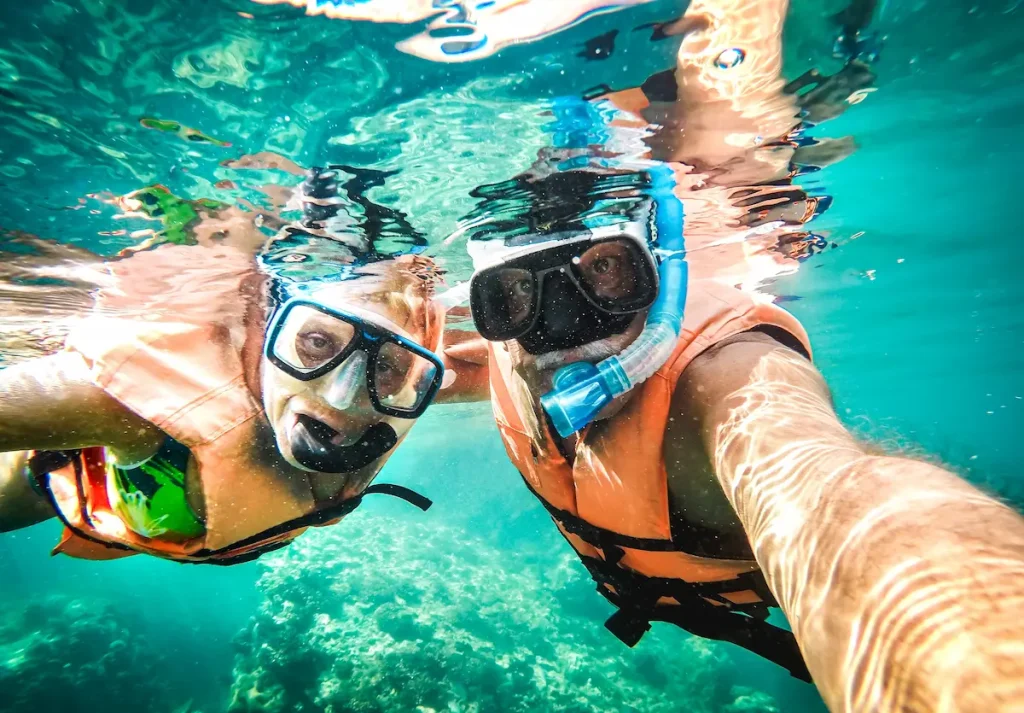
8. Best Time to Dive the Blue Hole
Choosing the time you want to visit Blue Hole for scuba diving can change everything about the trip you are planning. When you consider that the Red Sea is a well-established diving location every day of the year, then many people think it’s not necessary to watch the calendar. However, we can’t disregard the fact that it is important to dive when the sea is at its best.
The season where it seems best is in spring, which is from March to May, and in the fall, which lasts from September- November. The rustic air in these two months helps in enhancing the visual impact of the water; the weather is calm, and there is no adverse gender effect whatsoever either in the air or in the water, and equally pleasant temperatures can be found in these rooms for both layman and diving as well.
The last part of the year (June – August) is characterized by warm waters that are more welcoming than outstretched arms toward the nocturnally extreme situation experienced often in the hot desert when temperatures can reach even above 40 degrees Celsius. As long as the jam is concerned, the divers will frown as they leave the surface, but they will encounter excellent, relatively warm water temperature.
In winter, from December to February, the heat goes down, and at the same time, the water temperature drops by a few degrees. The reason why there are fewer people coming in this season is that it offers a more laid-back trip.
There is never a bad time to come visit the Blue Hole, which is always a memorable dive experience because of the beautiful marine life that is always present.
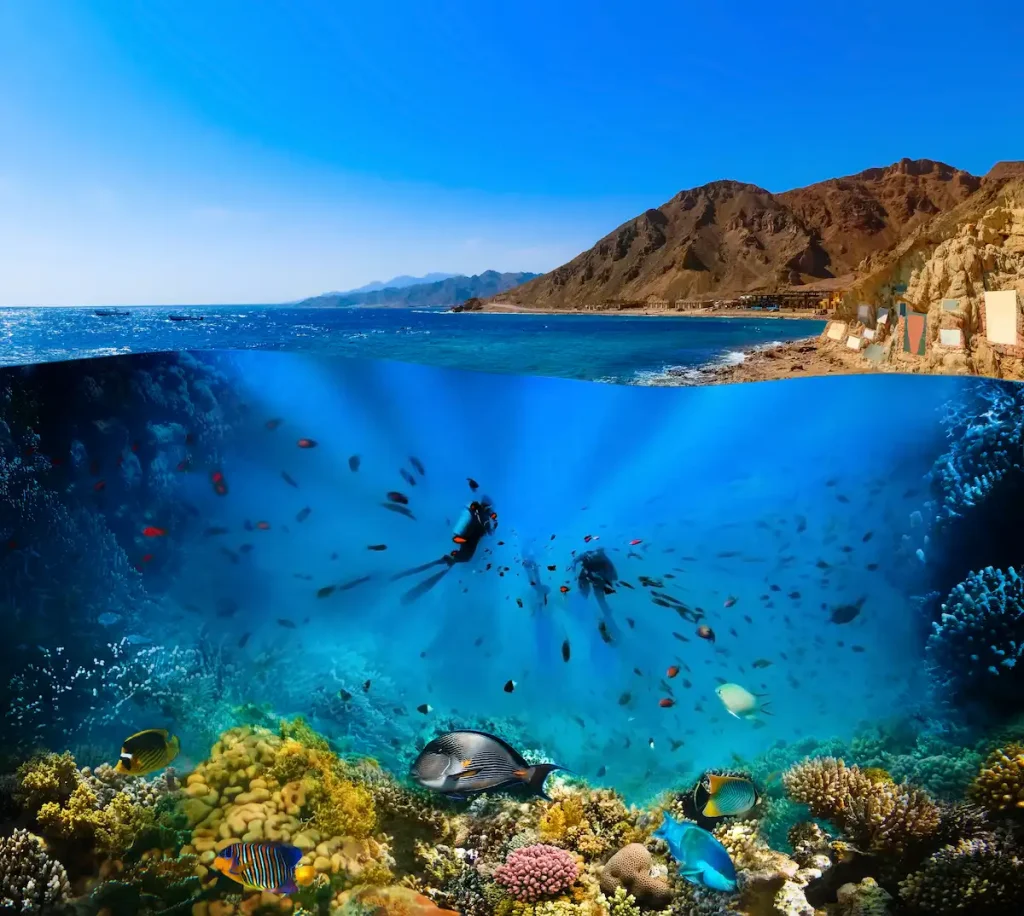
9. Practical Travel Information
Designing the logistics of a Blue Hole scuba diving tour in Egypt almost turns easy if one prefers Dahab as their primary town to dive Blue Hole, since there are many experts in scuba diving in Dahab, such as professional dive centers who organize guided Blue Hole trips daily, and thus, such scuba divers do not necessarily have to have any diving equipment. Some of these dive centers that will run the Blue Hole scuba diving trips will offer you a certified dive master and the equipment needed for the dive, as well as recreational or tech dives.
As for where to stay while in Dahab is concerned, there are many options that travelers can choose from. Backpackers with limited funds may opt for cheap dormitories or easy bed and breakfast places. If you stay in selected areas within Sharm, the management of that designated area deals with all single and multiple tourism activities the whole 24 hours. People who have some money and would cozy you after a dive might prefer to select mid-range hotels and luxury hotels within the area of stay.
-
How to Reach the Blue Hole and What to Expect in Costs
Usually, dive centers separate swimming sites and hotels so that several tourists are accommodated in the rooms and engage in another activity like snorkeling. Such swim sites include reef diving, shore diving, and deep diving, among others, while diving and snorkeling are some of the activities that require guests to enter the water.
The Blue Hole is only a 15-minute drive away from Dahab by taxi, and a jeep will take about the same period. In Sharm El-Sheikh, however, a tourist has a chance to sign up for a day tour where diving and transportation facilities are available. For those coming from Cairo, most catch a flight to Sharm and then take a bus or other means to get to St. Catherine, where the Blue Hole is located.
Rates come in comparison to the number of dives to be performed and the kind of service that will be provided. Usually, a single dive would cost $60-$80 with all the gear and a guide included. Multiple dive or multiple day packages typically reduce the price per dive.
👉 Tip: For a seamless experience, check out our exclusive Blue Hole Diving Packages that cover transfers, professional guides, and top-quality equipment.
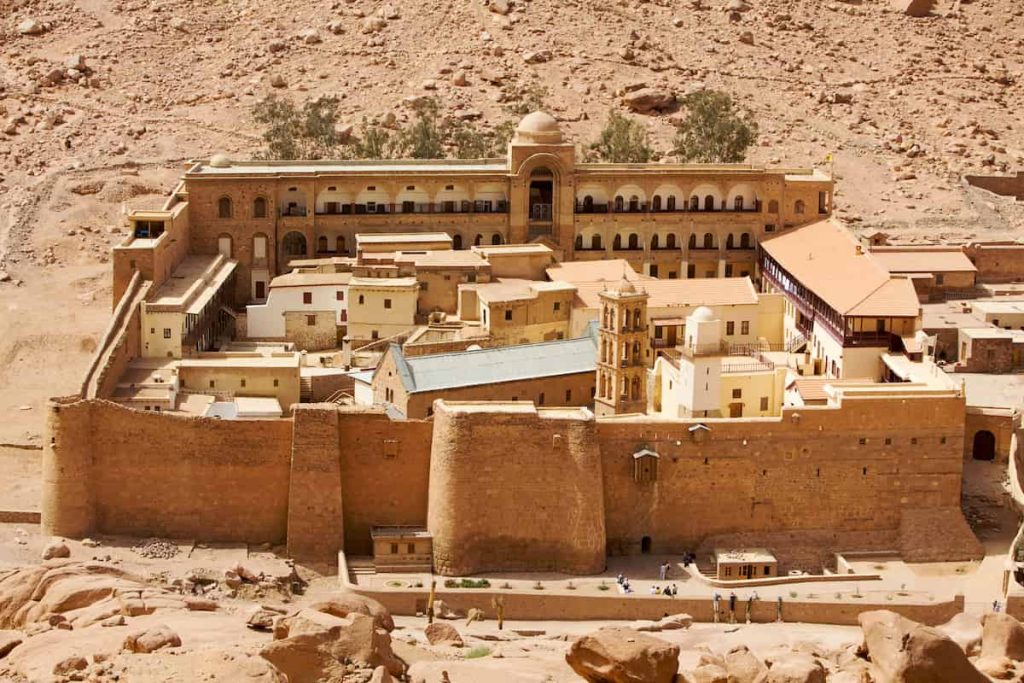
10. Cultural & Historical Context
It is not just the fabulous Blue Hole diving in Egypt, which is all the rage, but also the story of that diving, which contains a deep history worth its own separate layer. The Blue Hole location is situated in the mountainous territory of Dahab, where Bedouin tribes live and have a very interesting history of hospitality and sea-related life that renders Dahab a favorable place for holidaymakers. Many of its residents make money as guides, sailors, or managers of local hotels and cafes around the dive spot, so tourists have the opportunity to learn even more about the traditional culture of Sinai.
The dive destination, the Blue Hole, began to gain worldwide popularity in the 1980s and 1990s when many explorers talked about its beautiful underwater walls and especially the Arch that comes with a difficult approach. From that time, it has also been controversial, becoming as much a tourist destination as an element of finished tales.
Moreover, in proximity to the dive site, one can also come across the monuments to the memory of those divers who never managed to complete the deep or technical lines. All these monuments ensure that each person visiting the Blue Hole, although enchanted by its beauty, does not lose sight of the need to be careful, talented, and responsible in relation to diving.
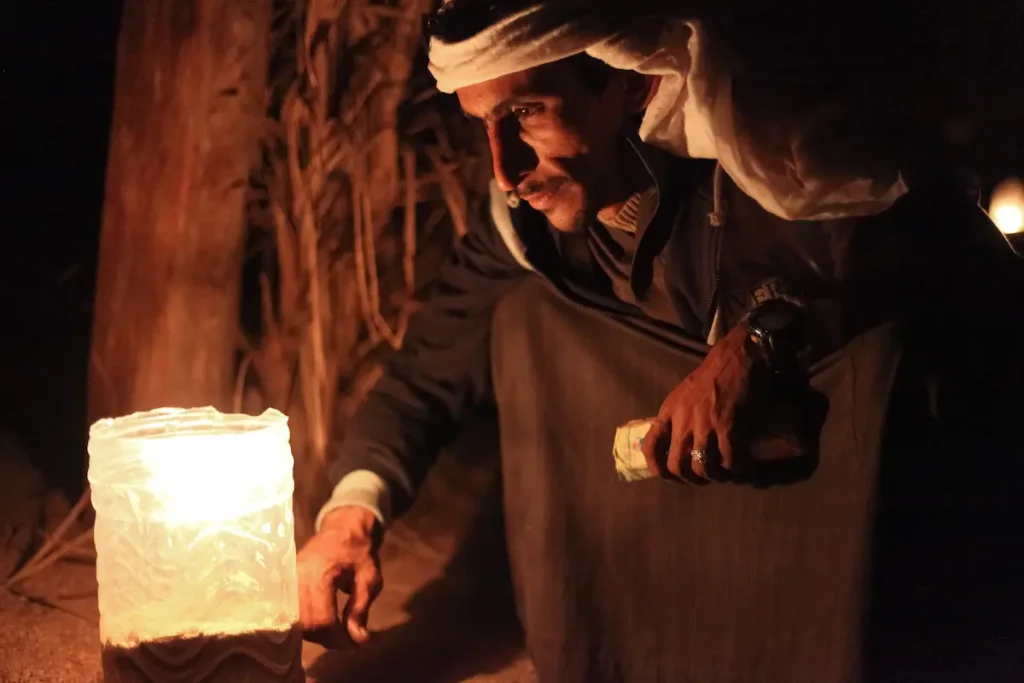
11. Other Dive Sites Near Dahab
While Blue Hole scuba diving in Egypt stands out as the most iconic experience in Dahab, the region offers several other world-class dive sites that attract divers of all levels.
-
The Canyon – Famous for its dramatic underwater crack that drops to more than 50 meters, The Canyon delivers both adventure and stunning geological scenery. Recreational divers can enjoy the upper section, while technical divers explore the deeper passages.
-
Lighthouse Reef – A favorite training and night-dive spot located right off Dahab’s main promenade. Its easy entry, calm conditions, and abundant marine life make it a perfect choice for both beginners and experienced divers.
-
Eel Garden – Known for the mesmerizing fields of garden eels swaying in the sand, this site combines unique wildlife encounters with beautiful reef formations.
For comparison, nearby Sharm El-Sheikh hosts some of Egypt’s most famous dive sites, including Ras Mohammed National Park and the historic Thistlegorm wreck. Many divers pair Dahab’s raw charm and relaxed vibe with Sharm’s high-profile sites to experience the best of both worlds in the Red Sea.
12. Tips for Divers & Travelers
To make the most of your Blue Hole scuba diving in Egypt adventure, keep these essential tips in mind:
-
Carry the right certifications – Advanced Open Water or higher gives you access to more dive routes. Technical training is a must if you plan to attempt the Arch.
-
Have valid dive insurance – The Blue Hole is a remote location, so coverage for diving-related incidents is highly recommended.
-
Stay hydrated and rested – The Sinai sun and diving exertion can be draining. Drink plenty of water and get enough sleep before heading out.
-
Respect marine life and reefs – Do not touch corals, chase fish, or leave waste behind. Preserving the fragile ecosystem ensures future divers can enjoy it too.
-
Explore beyond diving – Balance your trip with other Dahab experiences like camel rides, desert jeep tours, or stargazing in the mountains.
These small steps not only keep you safe but also enrich your journey, letting you enjoy both the thrill of diving and the charm of Sinai’s culture and landscapes.
13. Conclusion
Once you’ve signed up for the Blue Hole scuba diving in Egypt, it becomes clear that it is one of the most irresistible underwater adventures in the world. Its grand canyons, live coral reefs, and the ever-famous loop are among the best for those seasoned and advanced divers who just want to seek the excitement and also the beauty of underwater life. Along with these, the tiny reefs at the shallows and the dive sites beyond have such an appreciation that even snorkelers and non-certified divers can have their share of fun.
This balance of wonder and reverence typifies what is remarkable about the Blue Hole, a spot where the beauty of the environment is superb, but where there is also a need for caution and completion of a checklist of tasks. Despite the formidable challenges it presents, the dive can be said to be a mind-blowing dive. However, for those individuals who feel more comfortable staying on top of the water, the Bedouin way of life enjoyed by the residents, other dive options, and the low-key lifestyle, which is Dahab, are all reasons to go there as a destination.
But as one risks going deep, or merely sees the sights, it is abundantly clear the Blue Hole is a huge photomontage and a clear communication on the transcendent cruelty of the Red Sea.

